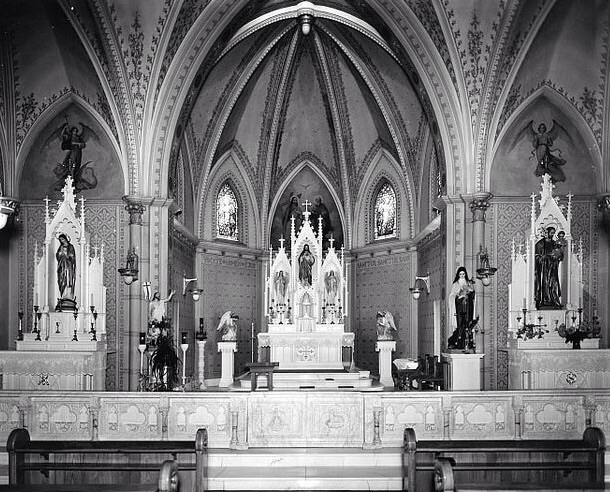Much has been written about the artistic and architectural wreckovation which occurred in many parishes in the years immediately following the Second Vatican Council. The modern iconoclasts surveyed the Catholic landscape during those years looking for altars to smash and statuary to evict from some of the most beautiful sanctuaries imaginable. Traditional aesthetics and liturgical continuity were out as many felt little obligation to transmit what prior generations had preserved and passed on to them.
In his short, but brilliant, treatise “The Binding Force of Tradition” (Sensus Traditionis Press, 2013) Father Chad Ripperger speaks of this assault against beauty. Far from excusing these excesses as mere architectural expressions of that era, Fr. Ripperger labels them as nothing less than “sins against charity”. He writes:
“Charity is defined as the supernatural virtue infused in the will by which the person loves God and one’s neighbor for the sake of God. If one loves God and loves one’s neighbor, one will always make sure the tradition is passed on intact for the greatest assurance possible of the salvation of those who receive that tradition. Even the very construction of monuments was often done for the love of God and therefore to destroy a monument without a sufficient reason is a sin against charity, i.e. a sin against the love of God. But it is also a sin against one’s neighbor who is deprived of the magnificent monument which would inspire him and lift his mind and heart to pray and to love God.” (pp. 47-48)
The smashing of centuries old high altars may have been the most egregious demonstration of what Fr. Ripperger means by the destroying of monuments. This assault against beauty was no less than an assault on tradition. Discussing this very topic, Catholic historian Michael Davies wrote:
“I well recollect reading in the newsletter of a parish in southeast London an account of a Protestant stonemason who had been heartbroken at having to smash an exquisitely beautiful marble altar in a convent and to replace it with what he described as “two great hunks of stone.” As a true craftsman, he found the task utterly repugnant, particularly as he was sure that there is not a stonemason in Britain who could produce such superb work today. The worthy gentleman would have been even more surprised had he been told that this act of vandalism was intended to promote the renewal of Catholic worship. What sort of renewal can be implemented only by destroying the holy and the beautiful?” (The Catholic Sanctuary and the Second Vatican Council, TAN Books, p. 24)
Truth, goodness and beauty. The Catholic Church teaches that it is through these transcendental properties of being that we find God Himself. Beauty is no less important than what is true or good when we speak of transmitting the faith. Therefore, when some in the Church intentionally destroyed beauty, they did nothing less than assault what was true and good. As Fr. Ripperger notes, it was a sin against the love of God and against one’s neighbor. He continues:
“The extensive recent changes in the tradition have rendered the saving of our souls more difficult, which is against charity. The assault on the monuments…has ravaged the affections which people have for the things of the faith and to which they have been attached in a rightly ordered manner. The impact it has had on people is clearly against charity and cannot be interpreted in any other way than sinful, often gravely sinful, especially when we are talking about the contempt with which these things were changed as well as the contempt shown to those who were attached to them in a rightly ordered manner.” (The Binding Force of Tradition, pp. 47-48)
This importance of beauty in the life of the faithful cannot be overstated.
In the nineteenth century Dostoevsky famously wrote that “beauty will save the world”. Here in the twenty first century we are beginning to see the restoration of beauty in our parishes. Recent years have seen church renovations which seek to recover the architectural heritage of Catholicism. Stained glass and statuary have made a comeback. Most of all, there has been a renewed emphasis on beauty within the liturgy; the gift and lasting legacy of Pope Benedict XVI. With the reemergence of the traditional Latin Mass we have even seen the return of high altars and communion rails in some churches.
In the years to come the primary purpose for the Church, the salvation of souls, will be greatly aided by this recovery of the true, the good and the beautiful. As Fr. Ripperger rightly observed, “If one loves God and loves one’s neighbor, one will always make sure the tradition is passed on intact for the greatest assurance possible of the salvation of those who receive that tradition.”




Sir George Milden said:
The narrator comments:
The quotations are from Bryan Houghton, Judith’s Marriage, 1987, p. 66. Note that Sir George was not a Catholic. Catholicism wasn’t his past, but he provided for its future, so far as he was able to.
Well said and so very true. Sadly, most of the Churches I have seen with the TLM are in ugly modern structures. I wonder sometimes if this is on purpose.